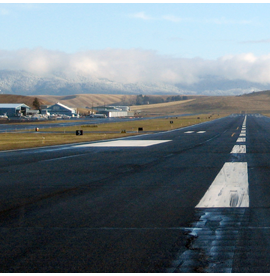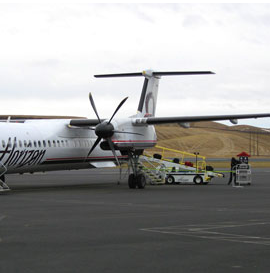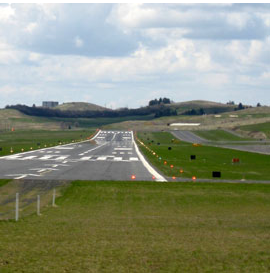
Pullman-Moscow Regional Airport
RUNWAY REALIGNMENT
ENVIRONMENTAL ASSESSMENT
 |
 |
 |
Timeline of Historical Studies
Pullman and Lewiston Regional Study: A study conducted during the 1970s that evaluated a consolidation of the Pullman and Lewiston airports into a single regional airport. Although a new airport location was identified in the study, the concept was not implemented.
PMRA Airport Master Plan (January 1999): A traditional master plan study, this report provides the basis for the current ALP. This plan identified many of the issues being addressed through the Phase II Master Plan. It included an assessment of alternatives to improve the runway from ARC B-II to ARC C-III.
PMRA Airport Site Investigation Report and Instrument Runway Designation Report (June 2004): This report started as an ALP update for the Airport's general aviation facilities. During the project, the scope was revised due to a change in commercial air service demands. As a result, the final report provided a preliminary analysis of runway design alternatives. The engineering assessments remain valid and provide valuable information.
Pullman-Moscow Regional Airport Master Plan — Phase I (2007): Formalized the selection of a preferred runway alternative on the existing airport site with a thorough air space evaluation and constructability review. It verified that a runway realignment of a five degree counter-clockwise rotation was the most practical means of satisfying current design standards and meeting the long-term growth potential of the airport within the confines of the existing site constraints. The study used the following characteristics to evaluate each design alternative:
- Fully complies with ARC C-III design standards
- Can accommodate a precision approach with 200' cloud ceiling and one-half mile visibility
- Can satisfy the airport's long-term needs with respect to both runway length and development potential within the confines of the existing site
- Is the most financially feasible to implement
The Phase I Master Plan was undertaken as the first of a two-part study with the understanding that the Phase II Master Plan would follow to complete the planning process for the preferred runway realignment alternative.
The final Phase I Master Plan is available for review.
Pullman-Moscow Regional Airport Master Plan—Phase II (2011): After the Phase I Master Plan identified a preferred alternative to realign the Airport's only runway, the Phase II Master Plan followed a traditional planning process to determine whether the project could be built. During the planning process, challenges to completing the runway realignment were identified and then solutions were developed to mitigate those challenges.
Working from only the Phase I preferred runway realignment alternative, the Phase II Master Plan considered the design impacts on the airport terminal and landside areas as well as the land use impact on adjacent communities and the university. Preliminary project costs were estimated and potential funding sources were explored. The Phase II Master Plan also included a construction feasibility study and a conceptual construction phasing schedule.
While this is significantly more airfield engineering work than a traditional planning effort, the goal of the Phase II Master Plan was to make sure there were no fatal flaws for construction. The Phase II analysis revealed that the preferred runway realignment has no fatal flaws that would prevent construction.
The final Phase II Master Plan is available for review.
© 2012 Mead & Hunt, Last updated: October 7, 2013